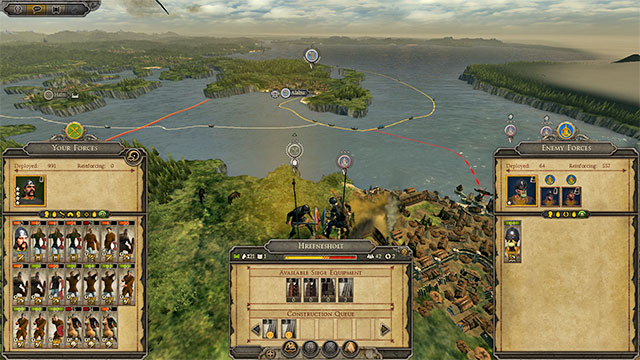Total War Attila: Siege

There are two types of siege. First is for cities that doesn't have fortifications. In that case attacking army can surround it or get directly to the siege. Siege machines aren't needed, and the possibility to build them is unavailable.
Second type is for cities that have fortifications. In that case, before attacking you must build siege machines. Ladders are enough. If you use the option to automatically settle battles or you have artillery, then prepare ladders and immediately start the siege. In other case you should prepare better equipment, such as siege towers.
Siege gradually damage walls and settlements buildings. If you don't want to pay for repairs, finish the siege as quickly as possible. Don't use artillery, rams and don't put buildings on fire as it will only increase the damage.
Outing
When enemy is starting a siege, you can decide whether you want to fight with him in the city or on the foreground. First decision might end with damaging many buildings due to artillery shooting or burning and you will need to pay for repairs. But the second means leaving good defense positions, guarding towers and gates and instead fighting on a plain or in the forest. Because of that, outings should be used in two situations - when fortifications are weak, damaged or destroyed, and when most of your army consists of cavalry, that fights much better on a plain than in narrow city streets.
Siege machines
Difference between machines is in time needed for creating them, their amount and usefulness during siege. Light ladders can be created in one turn, in packs of four, while light siege towers requires at least two turns and are created in pairs. The more time expensive machine, the greater its durability and effectiveness on the battlefield. Ladders won't cover an assaulting infantry, but siege towers will. Siege towers won't destroy walls, but battering ram will. Siege machines should be build based on how and why you want to get to the city. If you conquer a city without destroying its walls, you won't be needing to repair them later. But getting through the walls allow you to get to the city quicker, with larger forces. In first case towers and ladders will be better, in second battering rams and delivered earlier before the siege catapults.
How much machines you can create in one turn is based on the numbers of army. The larger it is, the more you can create in one turn.
Defenders tiredness
Each city has a limit of turns, after which defenders give up. The thing is, it is usually too long to even think about using it. A city protected by four, and assaulted by twenty formations can protect themselves even for seventeen turns. It means waiting for four years of game time, while trouble can be solved with one siege. So don't try to starve defenders, even if at first glance it seems like a good idea. It's a waste of time.
Blocking ports
A specific type of siege. This order blocks enemy port from the rest of the world. Trade is interrupted. Enemy won't be able to create or replenish fleets. Because of that, blocking is a useful order if your target is to limit enemy economy or not allowing him to rebuild his fleets. Enemies that have only one port that is their only trading connection with the world will be especially volatile to this tactic. If you find such port, and you don't want or can't conquer it at once, block it and in the meantime gather some land armies around it.
Blocking ports doesn't completely cuts a settlement from the world, which means you can't starve defenders with it. So conducting a siege from the land is required. It is best to connect both those methods, which will completely cut a settlement from the world. If as a side effect you will weaker enemy economy and his military potential, it is even better for you.
You are not permitted to copy any image, text or info from this page. This site is not associated with and/or endorsed by the developers and the publishers. All logos and images are copyrighted by their respective owners.
Copyright © 2000 - 2025 Webedia Polska SA for gamepressure.com, unofficial game guides, walkthroughs, secrets, game tips, maps & strategies for top games.
